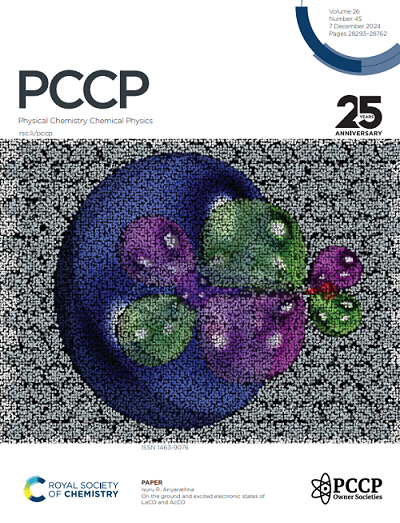High performance photocatalytic water splitting in two-dimensional BN/Janus SnSSe heterojunctions: ab initio study
IF 2.9
3区 化学
Q3 CHEMISTRY, PHYSICAL
引用次数: 0
Abstract
Designing and exploring a photocatalyst with interfacial electric fields for hydrogen production via water splitting is a critical area of research. To achieve efficient hydrolysis reactions, heterojunction materials have garnered significant attention due to their excellent electronic structures and interfacial properties. In this study, we designed a 2D BN/SnSSe heterojunction and investigated its photovoltaic properties through first-principles calculations. We found that the BN/SSnSe heterojunction is a type-II structure, with electron mobility (μe) and hole mobility (μh) of 1257.32 and 439.73 cm2 V−1 s−1, respectively. By modulating the interlayer spacing to 2.7 Å, we successfully achieved the desired photocatalytic band-edge positions (CBM > −4.44 eV, VBM < −5.67 eV). Additionally, we discovered a unique phenomenon in the oxygen evolution reaction (OER), where the peroxide groups (OOH) automatically detach when H+ is adsorbed on the reaction intermediate *OOH, leading to the production of O2 and H2. We refer to this process as the H-ion induced desorption mechanism (H-IIDM). This mechanism not only enables the separation of the OER and hydrogen evolution reaction (HER) on different surfaces but also further enhances the photocatalytic efficiency. Furthermore, the BN/SnSSe heterojunction exhibits excellent visible-light absorption with a high optical absorption coefficient (105 cm−1), and BN/SSnSe has a high solar hydrogen production efficiency (32.61%), significantly outperforming conventional 2D photocatalysts. These findings suggest that the BN/SnSSe heterojunction holds great potential as a photocatalyst for water splitting applications.

求助全文
约1分钟内获得全文
求助全文
来源期刊

Physical Chemistry Chemical Physics
化学-物理:原子、分子和化学物理
CiteScore
5.50
自引率
9.10%
发文量
2675
审稿时长
2.0 months
期刊介绍:
Physical Chemistry Chemical Physics (PCCP) is an international journal co-owned by 19 physical chemistry and physics societies from around the world. This journal publishes original, cutting-edge research in physical chemistry, chemical physics and biophysical chemistry. To be suitable for publication in PCCP, articles must include significant innovation and/or insight into physical chemistry; this is the most important criterion that reviewers and Editors will judge against when evaluating submissions.
The journal has a broad scope and welcomes contributions spanning experiment, theory, computation and data science. Topical coverage includes spectroscopy, dynamics, kinetics, statistical mechanics, thermodynamics, electrochemistry, catalysis, surface science, quantum mechanics, quantum computing and machine learning. Interdisciplinary research areas such as polymers and soft matter, materials, nanoscience, energy, surfaces/interfaces, and biophysical chemistry are welcomed if they demonstrate significant innovation and/or insight into physical chemistry. Joined experimental/theoretical studies are particularly appreciated when complementary and based on up-to-date approaches.
 求助内容:
求助内容: 应助结果提醒方式:
应助结果提醒方式:


